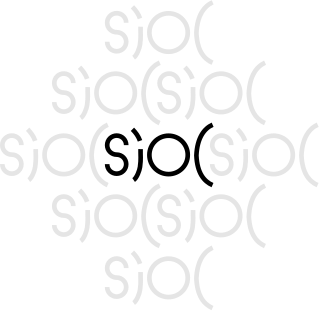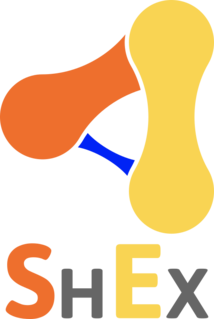Related Research Articles
The Semantic Web has the ultimate goal of making a machine understand Internet data. To enable the encoding of semantics with the data, well-known technologies are used such as RDF and OWL. These technologies formally represent the meaning involved in information. For example, ontology can describe concepts, relationships between things, and categories of things. These embedded semantics offer significant advantages such as reasoning over data and dealing with heterogeneous data sources.
The Resource Description Framework (RDF) is a family of World Wide Web Consortium (W3C) specifications originally designed as a metadata data model. It has come to be used as a general method for conceptual description or modeling of information that is implemented in web resources, using a variety of syntax notations and data serialization formats. It is also used in knowledge management applications.
A microformat is a World Wide Web-based approach to semantic markup which uses HTML/XHTML tags supported for other purposes to convey additional metadata and other attributes in web pages and other contexts that support (X)HTML, such as RSS. This approach allows software to process information intended for end-users automatically.
GRDDL is a markup format for Gleaning Resource Descriptions from Dialects of Languages. It is a W3C Recommendation, and enables users to obtain RDF triples out of XML documents, including XHTML. The GRDDL specification shows examples using XSLT, however it was intended to be abstract enough to allow for other implementations as well. It became a Recommendation on September 11, 2007.
RDFa is a W3C Recommendation that adds a set of attribute-level extensions to HTML, XHTML and various XML-based document types for embedding rich metadata within Web documents. The RDF data-model mapping enables its use for embedding RDF subject-predicate-object expressions within XHTML documents. It also enables the extraction of RDF model triples by compliant user agents.
Semantic publishing on the Web, or semantic web publishing, refers to publishing information on the web as documents accompanied by semantic markup. Semantic publication provides a way for computers to understand the structure and even the meaning of the published information, making information search and data integration more efficient.

Semantically-Interlinked Online Communities Project is a Semantic Web technology. SIOC provides methods for interconnecting discussion methods such as blogs, forums and mailing lists to each other. It consists of the SIOC ontology, an open-standard machine readable format for expressing the information contained both explicitly and implicitly in Internet discussion methods, of SIOC metadata producers for a number of popular blogging platforms and content management systems, and of storage and browsing/searching systems for leveraging this SIOC data.
Geo is a microformat used for marking up WGS84 geographical coordinates (latitude;longitude) in (X)HTML. Although termed a "draft" specification, this is a formality, and the format is stable and in widespread use; not least as a sub-set of the published hCalendar and hCard microformat specifications, neither of which is still a draft.
Semantic HTML is the use of HTML markup to reinforce the semantics, or meaning, of the information in webpages and web applications rather than merely to define its presentation or look. Semantic HTML is processed by traditional web browsers as well as by many other user agents. CSS is used to suggest its presentation to human users.
Hyperdata are data objects linked to other data objects in other places, as hypertext indicates text linked to other text in other places. Hyperdata enables formation of a web of data, evolving from the "data on the Web" that is not inter-related.

The Semantic Web Stack, also known as Semantic Web Cake or Semantic Web Layer Cake, illustrates the architecture of the Semantic Web.
The Web of Things (WoT) is software architectural styles and programming patterns that allow real-world objects to be part of the World Wide Web. Similarly to what the Web is to the Internet, the Web of Things provides an Application Layer that simplifies the creation of Internet of Things (IoT) applications composed of multiple devices across different platforms and application domains. Differently from IoT which focuses on the Network Layer, WoT assumes that the connectivity between the devices is achieved and focuses on how to build applications.
Microdata is a WHATWG HTML specification used to nest metadata within existing content on web pages. Search engines, web crawlers, and browsers can extract and process Microdata from a web page and use it to provide a richer browsing experience for users. Search engines benefit greatly from direct access to this structured data because it allows them to understand the information on web pages and provide more relevant results to users. Microdata uses a supporting vocabulary to describe an item and name-value pairs to assign values to its properties. Microdata is an attempt to provide a simpler way of annotating HTML elements with machine-readable tags than the similar approaches of using RDFa and microformats.

Named graphs are a key concept of Semantic Web architecture in which a set of Resource Description Framework statements are identified using a URI, allowing descriptions to be made of that set of statements such as context, provenance information or other such metadata.
XHTML+RDFa is an extended version of the XHTML markup language for supporting RDF through a collection of attributes and processing rules in the form of well-formed XML documents. XHTML+RDFa is one of the techniques used to develop Semantic Web content by embedding rich semantic markup. Version 1.1 of the language is a superset of XHTML 1.1, integrating the attributes according to RDFa Core 1.1. In other words, it is an RDFa support through XHTML Modularization.
Schema.org is a collaborative community activity with a mission to "create, maintain, and promote schemas for structured data on the Internet, on web pages, in email messages, and beyond." Webmasters use this shared vocabulary to structure metadata on their websites and to help search engines understand the published content, a technique known as search engine optimization.
JSON-LD, is a method of encoding Linked Data using JSON. It was a goal to require as little effort as possible from developers to transform their existing JSON to JSON-LD. This allows data to be serialized in a way that is similar to traditional JSON. It is a World Wide Web Consortium Recommendation. It was initially developed by the JSON for Linking Data Community Group before being transferred to the RDF Working Group for review, improvement, and standardization.
Machine-readable data, or computer-readable data, is data in a format that can be easily processed by a computer. Machine-readable data must be structured data.

Shape Expressions (ShEx) is a language for validating and describing RDF.
Linked Data Notifications (LDN) is a W3C Recommendation that describes a communications protocol based on HTTP, URI, and RDF on how servers (receivers) can receive messages pushed to them by applications (senders), as well as how other applications (consumers) may retrieve those messages. Any web resource can advertise a receiving endpoint (inbox) for notification messages. Messages are expressed in RDF, and can contain arbitrary data.